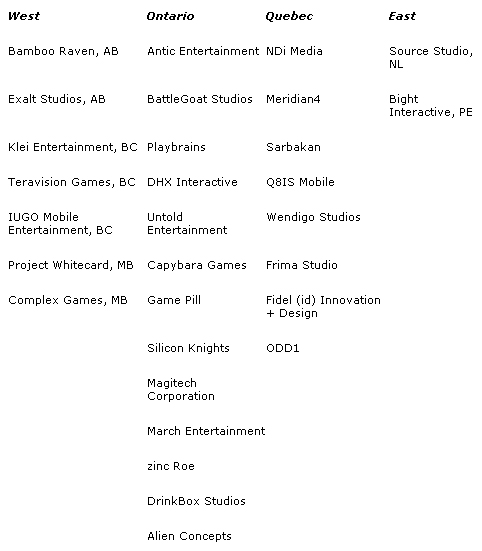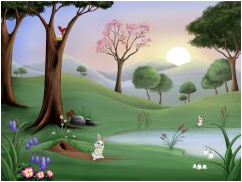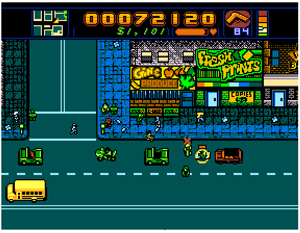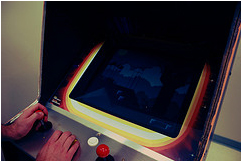 For the last three years we’ve spent the final weekend in January periodically checking in on a group of people who shut themselves in a big room full of computers and ideas for 48 hours. Each of those years has seen this event grow, and 2011 was Vancouver’s largest Global Game Jam event ever, with about 120 participants. One other note of importance – 20-25% of the 2011 Jam participants were female. Awesome.
For the last three years we’ve spent the final weekend in January periodically checking in on a group of people who shut themselves in a big room full of computers and ideas for 48 hours. Each of those years has seen this event grow, and 2011 was Vancouver’s largest Global Game Jam event ever, with about 120 participants. One other note of importance – 20-25% of the 2011 Jam participants were female. Awesome. 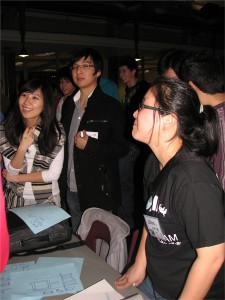
Held in the Main Hall of BCIT’s main Burnaby campus, this year’s Global Game Jam opened with presentations from Scott Jones, co-host of Electric Playground, and Kelly Zmak, the former president of Vancouver’s Radical Entertainment. Unfortunately, due to the demonic nature of traffic in the Lower Mainland, especially for those of us who live out in the Fraser Valley, we completely missed Scott’s opening comments as well as the first few minutes of Kelly’s  presentation. I freely admit that I never tire of hearing a talk given by Kelly – he doesn’t pull any punches, and he will tell you exactly the way things are in this fine industry. Even while he is forcing you to face the reality of how many titles actually become blockbusters, he is still encouraging developers new and veteran, to get out there and give it their best shot anyway. You don’t have to work in a creative studio to benefit from the advice Kelly shares, either. Many of his suggestions are applicable to any discipline, and I never fail to be anything but inspired whenever I’ve been to a Kelly Zmak presentation. Many of the participants in this past Global Game Jam obviously took Kelly’s words to heart as well, because there were some very good products that emerged from this 48 hour exercise in innovation and creativity.
presentation. I freely admit that I never tire of hearing a talk given by Kelly – he doesn’t pull any punches, and he will tell you exactly the way things are in this fine industry. Even while he is forcing you to face the reality of how many titles actually become blockbusters, he is still encouraging developers new and veteran, to get out there and give it their best shot anyway. You don’t have to work in a creative studio to benefit from the advice Kelly shares, either. Many of his suggestions are applicable to any discipline, and I never fail to be anything but inspired whenever I’ve been to a Kelly Zmak presentation. Many of the participants in this past Global Game Jam obviously took Kelly’s words to heart as well, because there were some very good products that emerged from this 48 hour exercise in innovation and creativity.
 Before I go too much further, I would like to note that the Global Game Jam is an initiative of the International Game Developers Association, and this year took place in 169 registered locations around the world. This total does not include the informal game jams that were also held over the same weekend, such as the one taking place at New Media Manitoba called So Many Rooms, which was a unique twist on the jam concept, but more about that in a different post.
Before I go too much further, I would like to note that the Global Game Jam is an initiative of the International Game Developers Association, and this year took place in 169 registered locations around the world. This total does not include the informal game jams that were also held over the same weekend, such as the one taking place at New Media Manitoba called So Many Rooms, which was a unique twist on the jam concept, but more about that in a different post.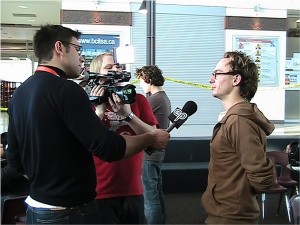 For more photos of the BCIT event, please see our GGJ Gallery. There are more photos on the Global Game Jam Vancouver web site as well.
For more photos of the BCIT event, please see our GGJ Gallery. There are more photos on the Global Game Jam Vancouver web site as well.
The jams also would not happen without the support of venues, schools, corporate partners and of course, volunteers and industry mentors. A large part of the Vancouver Game Jam support comes from these post-secondary educational facilities: BCIT and UBC with the assistance of the Centre for Digital Media and SFU. Other supporting sponsors include the Natural Sciences and Engineering Research Council of Canada, AirG, Microsoft, Wacom, Radical Entertainment and Electronic Arts Canada. Other supporters and friends of the local Global Game Jam are the Canadian Video Game Awards, the Vancouver Silverlight User Group, and ourselves. It was also very cool to see Electric Playground attending and interviewing participants, as well as giving the jam some airtime on its February 8th episode. You can watch the EP video here.
Global supporters and sponsors of Global Game Jam include Game Salad, Intel AppDeveloper Programme, Autodesk, GameSpy, gamesauce, triOS College and ACM. Once again, a huge thank you to the volunteers, the instructors and the corporations who all work together to make the Global Game Jam such an awesome weekend of inspiration.
This year’s Jam began with everyone gathering in groups based on their disciplines. Each person had a coloured “skill dot” on his or her name tag, which made it very easy for others to find artists, programmers, designers or the 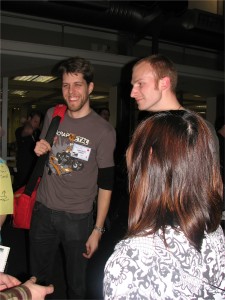 very elusive audio folk. Note to those of you with audio skills: come out to next year’s Game Jam, your skills are in high demand. You will be very popular. Once the skills groups were formed, attendees were put through some ice-breaking exercises, discussing their favourite games, super-powers and why their respective disciplines are the best. With the announcement of this year’s theme of Extinction, the jammers were encouraged to come up with some quick game concepts that would then be pitched to the entire room.
very elusive audio folk. Note to those of you with audio skills: come out to next year’s Game Jam, your skills are in high demand. You will be very popular. Once the skills groups were formed, attendees were put through some ice-breaking exercises, discussing their favourite games, super-powers and why their respective disciplines are the best. With the announcement of this year’s theme of Extinction, the jammers were encouraged to come up with some quick game concepts that would then be pitched to the entire room.
Needless to say, in a room full of creative people, there was a huge variety of game concepts that covered everything from dinosaurs to aliens and time travel. It never ceases to amaze me how quickly and reasonably clearly the ideas are formed and presented. After the presentations, it was time to start the team recruiting and previs work before settling in for the next several hours of coding, drawing, editing, testing and reiterating with maybe a bit of sleep mixed in.
When we returned to the Jam on Sunday afternoon, the BCIT Main Hall was still a hive of activity. At first glance you wouldn’t know that a good part of this group was heavily sleep-deprived and that for some, thought processes were by now running at something akin to dial-up mode. However, as we moved among the developers and asked for demonstrations or their thoughts on the weekend, as tired as they were, each team managed to talk about their projects with energy, enthusiasm and passion.
Without a doubt the team with the best game trailer was RawR Games, developers of, coincidentally, the game chosen as Top Pick for the Vancouver event. Dino Fling is a 2D game that asks the player to save dinosaurs from rising post-Ice Age waters by flinging them onto a rescue boat.
[youtube:http://www.youtube.com/watch?v=Mk4jods47dY]
Naturally the game gets more challenging as the water rises, covering the beach and making the distance you need to fling each dinosaur wider and wider. The RawR Games team perhaps had a bit of hand-up as members of the squad had been to previous Jam events and also work in the game development industry, but it was still important to them to get a product completed within the 48 hour time limit, and that the game be fun to play.
Nick Waanders, co-founder of Slick Entertainment, said that one of the challenges for him personally was having each new iteration of Dino Fling better than the last, each one topping the features and fun factor of the previous. He said that it’s very important to get into the habit of taking notes throughout the development cycle, don’t count on your memory to keep all of the ideas straight. He feels that this is a very important part of development discipline that will help keep your work flow from getting all tangled up. Flash Punk creator Chevy Ray Johnston and Tatham Johnston, a Junior Gameplay Programmer at Klei Entertainment while Rachel Simpson is a Game Jam veteran, 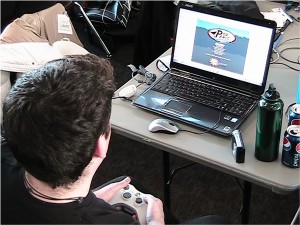 Daniel Ritchie is a UBC Computer Sciences student and Celeste Medina is a Layout Artist at Luximation (by the way, they’re hiring). One other cool footnote before moving on, Chevy’s Flash Punk engine was used by other teams at the Jam for their games.
Daniel Ritchie is a UBC Computer Sciences student and Celeste Medina is a Layout Artist at Luximation (by the way, they’re hiring). One other cool footnote before moving on, Chevy’s Flash Punk engine was used by other teams at the Jam for their games.
Pod Panic was another title which was high on the list of favourite games, with the premise of this title to both learn about the Orca pods who inhabit our coastal waters and the dangers they face every day through pollution and over-fishing. Designed and built by James Karg, Douglas Richardson, Shane Morin, Jacob Kwitkoski, Spencer Daemore and Travis Hilliard, Pod Panic was developed on the XNA platform for Xbox and Windows. The premise of the game is to help your pod of Orca whales navigate several levels, each named for a coastal area and with increasing levels of difficulty. Pod Panic was inspired by the David Suzuki Foundation and the real-life plight of our whale populations and other endangered species.
Another friend of ours, indie developer Jake Birkett, was on the team which created the germ-ridden game Invasion of Giant Planet-Eating Bacteria From Outer Space, along with Alex Vostrov, Steven Pugh, Khadija Ghazi and Samppa Raski. Jake and Alex are the co-founders of Full Indie, a meetup and resource gr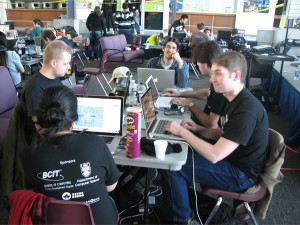 oup for independent developers. The premise behind their flash-based game is to rocket about outer space jabbing the giant bacteria with your Inoculazer, thereby curing different diseases and saving the planets. Of course it’s not as easy as that sounds – each type of bug requires a certain type of cure, and every cure has a side effect. You must match the colour of the cure to the colour of the bacteria, and due to the aforementioned side effects, strategy and timing do play an important part in winning this game. Jake’s advice on game design is to not be afraid to think big and add loads of features to your list, but also don’t be afraid to wield a big axe when it comes time to pare down what parts make it into the game and which don’t. His main take-away from the Jam weekend was a reinforcing of his knowledge and the sharing of experience both as a giver and as a receiver.
oup for independent developers. The premise behind their flash-based game is to rocket about outer space jabbing the giant bacteria with your Inoculazer, thereby curing different diseases and saving the planets. Of course it’s not as easy as that sounds – each type of bug requires a certain type of cure, and every cure has a side effect. You must match the colour of the cure to the colour of the bacteria, and due to the aforementioned side effects, strategy and timing do play an important part in winning this game. Jake’s advice on game design is to not be afraid to think big and add loads of features to your list, but also don’t be afraid to wield a big axe when it comes time to pare down what parts make it into the game and which don’t. His main take-away from the Jam weekend was a reinforcing of his knowledge and the sharing of experience both as a giver and as a receiver.
Meanwhile another galactic planet-destroying game with yet another twist was being developed just a few tables away. MDP Earth Defender was built using the Unity platform and is for two players who are required to switch between Savior and Destroyer roles. The Destroyer literally tries to destroy Earth with nuclear bombs while the Savior sends up Claw Satellites which need to intercept the bombs before they blow the Earth into tiny little bits. The player with the most survivors at the end of the round wins. MDP Earth Defender was developed by Clayton Campbell, Don Lee, Eric Raue, James Xia, Jason Tseng, and Tiva Quinn.
Another game of galactic proportions (and name) was Super Hyper Mega Deluxe Earth Annihilation – it seems 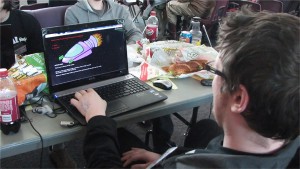 more than just a few people were trying to make Earth extinct, but then I guess it’s an easy target, what with being big and round and floating around in space on a pre-determined path. In this game, instead of defending Earth, the player must protect the mother ship death ray that is trying to destroy our fine planet. The Earthlings have the nerve to try and defend themselves by sending out waves of spacefighters, and it’s the player’s job to remove them from existence. This team took their development cycle practically to the wire, finishing up just one hour before the deadline. Developers Alex Mcgilvray and Ryan Sheffer said that one of the most important pieces of advice that they could pass along about participating in a game jam is to get as much coding done as possible early on in the event, because a lack of sleep means coding errors.
more than just a few people were trying to make Earth extinct, but then I guess it’s an easy target, what with being big and round and floating around in space on a pre-determined path. In this game, instead of defending Earth, the player must protect the mother ship death ray that is trying to destroy our fine planet. The Earthlings have the nerve to try and defend themselves by sending out waves of spacefighters, and it’s the player’s job to remove them from existence. This team took their development cycle practically to the wire, finishing up just one hour before the deadline. Developers Alex Mcgilvray and Ryan Sheffer said that one of the most important pieces of advice that they could pass along about participating in a game jam is to get as much coding done as possible early on in the event, because a lack of sleep means coding errors.
One of the most imaginative titles we took a look at over the weekend was Squishy Squid Sex, whereby the gamer must ensure that the squid population increases through recreation…or, re-creation – they both apply. This team, which learned the importance of early iteration, prototyping and software compatibility, showed a great deal of creativity and imagination in their product. The development team for Squishy Squid Sex was Airlia Hansen, Ben Sheftel, Nathaniel Kopjar, Jonathan Clark and Alice Tai.
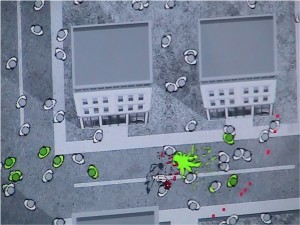 Moving back to the germ theme was Containment, a top-down infestation elimination game. This browser-based game is kind of like a blind man’s bluff, because the player doesn’t know until a character is killed if it was one of the germ carriers or not, and a process of elimination must be used to search out the three germ bearers. The catch, and you know there’s always a catch, is that if you kill the entire population you lose. You win the game by saving the highest number of citizens as you possibly can. Oh, and of course there’s a timer, too. When this team was formed to come up with a product, they were all strangers, having never met each other prior to the jam weekend. Ben James is a computer programmer by day, but not in the digital media sector, and he said that he has realized how hard it is to make games (actually, we heard that a lot over the weekend), and that it’s important to focus the scope of your project early. Other team members included Jen Kim, Arnold Ip, Colin Cove and “Got Quail”.
Moving back to the germ theme was Containment, a top-down infestation elimination game. This browser-based game is kind of like a blind man’s bluff, because the player doesn’t know until a character is killed if it was one of the germ carriers or not, and a process of elimination must be used to search out the three germ bearers. The catch, and you know there’s always a catch, is that if you kill the entire population you lose. You win the game by saving the highest number of citizens as you possibly can. Oh, and of course there’s a timer, too. When this team was formed to come up with a product, they were all strangers, having never met each other prior to the jam weekend. Ben James is a computer programmer by day, but not in the digital media sector, and he said that he has realized how hard it is to make games (actually, we heard that a lot over the weekend), and that it’s important to focus the scope of your project early. Other team members included Jen Kim, Arnold Ip, Colin Cove and “Got Quail”.
[youtube:http://www.youtube.com/watch?v=87RDRXFEeg8]
We did not have time to visit with every game team and participant, that’s something I’d like to be able to accomplish next year, but over-all, the consensus about Global Game Jam is that the event is a lot of fun and a fantastic learning experience. The sharing of knowledge between students, professionals and hobbyists is something that is not always easily obtainable, and there is a combined sense of collaboration and competition – because while there isn’t a prize for making the best game or finishing first, there is a sense of pride and accomplishment that goes along with the lack of sleep, the software glitches and the new friendships. Much of the success of any Game Jam event, whether it’s a part of the Global weekend or otherwise, falls on the shoulders of its organizers, volunteers and supporters. The willingness of both industry mentors and teachers to help and guide those who strive to be a part of this wonderful industry is sometimes a “thank you” that may not be said loudly or often enough.
If any of you reading this got the “wow this is cool” feeling, I hope you will carry that feeling forward and participate next year, in any capacity be it participant, volunteer, sponsor or leader. In 2011 there were at least a dozen Game Jam locations across the country (72 across North America), wouldn’t it be great if next year there were twice the number of locations, participants and sponsors?
 via Telefilm Canada, who is pleased to announce its support of 30 Canadian companies attending the 2011 Game Developers Conference (GDC) and Game Connection America in San Francisco. Taking place February 28th to March 4th, GDC is the world’s largest industry-only event dedicated to the advancement of interactive entertainment. Game Connection America (March 1st to 3rd) is an international marketplace for game developers, service providers and publishers looking to expand their network and find business partners.
via Telefilm Canada, who is pleased to announce its support of 30 Canadian companies attending the 2011 Game Developers Conference (GDC) and Game Connection America in San Francisco. Taking place February 28th to March 4th, GDC is the world’s largest industry-only event dedicated to the advancement of interactive entertainment. Game Connection America (March 1st to 3rd) is an international marketplace for game developers, service providers and publishers looking to expand their network and find business partners. Print This Post
Print This Post
